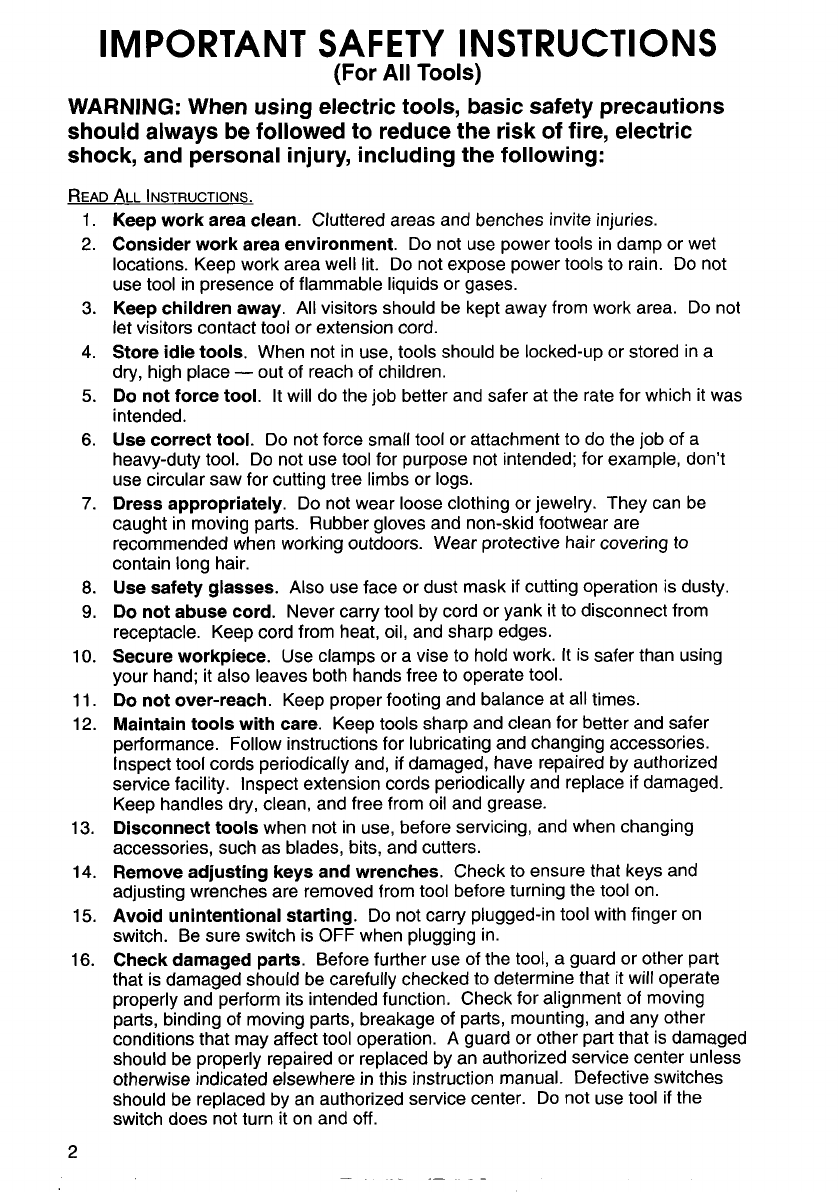
IMPORTANT
SAFETY
INSTRUCTIONS
(For All
Tools)
WARNING: When using electric tools, basic safety precautions
should
always
be
followed to reduce the risk of fire, electric
shock, and personal injury, including the following:
READ
ALL
INSTRUCTIONS.
1.
2.
3.
4.
5.
6.
7.
8.
9.
10.
11.
12.
13.
14.
15.
16.
2
Keep work area clean.
Cluttered areas and benches invite injuries.
Consider work area environment.
Do
not use power tools in damp or wet
locations. Keep work area well lit.
Do
not expose power tools to rain.
Do
not
use tool in presence of flammable liquids or gases.
Keep children away.
All
visitors should be kept away from work area.
Do
not
let visitors contact
tool
or extension cord.
Store idle tools.
When not in use,
tools
should be locked-up or stored in a
dry, high place
-
out of reach of children.
Do not force tool.
It
will do the job better and safer at the rate for which it was
intended.
Use correct tool.
Do
not force small tool or attachment to do the job
of
a
heavy-duty tool.
Do
not use
tool
for purpose not intended; for example, don’t
use circular saw for cutting tree limbs or logs.
Dress appropriately.
Do
not wear loose clothing or jewelry. They can be
caught in moving parts. Rubber gloves and non-skid footwear are
recommended when working outdoors. Wear protective hair covering
to
contain long hair.
Use safety glasses.
Also
use face or dust mask
if
cutting operation is dusty.
Do not abuse cord.
Never carry tool by cord or yank it
to
disconnect from
receptacle. Keep cord from heat, oil, and sharp edges.
Secure workpiece.
Use clamps or a vise to hold work. It is safer than using
your hand; it also leaves both hands free
to
operate tool.
Do
not over-reach.
Keep proper footing and balance at all times.
Maintain tools with care.
Keep tools sharp and clean for better and safer
performance. Follow instructions for lubricating and changing accessories.
Inspect tool cords periodically and, if damaged, have repaired by authorized
service facility. Inspect extension cords periodically and replace
if
damaged.
Keep handles dry, clean, and free from oil and grease.
Disconnect tools
when not in use, before servicing, and when changing
accessories, such as blades, bits, and cutters.
Remove adjusting keys and wrenches.
Check to ensure that keys and
adjusting wrenches are removed from
tool
before turning the tool on.
Avoid unintentional starting.
Do
not carry plugged-in tool with finger on
switch. Be sure switch is OFF when plugging in.
Check damaged parts.
Before further use of the
tool,
a guard or other part
that is damaged should be carefully checked to determine that it will operate
properly and perform its intended function. Check for alignment of moving
parts, binding of moving parts, breakage of parts, mounting, and any other
conditions that may affect tool operation.
A
guard or other part that is damaged
should be properly repaired or replaced by an authorized service center unless
otherwise indicated elsewhere
in
this instruction manual. Defective switches
should be replaced by an authorized service center.
Do
not use tool
if
the
switch does
not
turn it on and off.

















